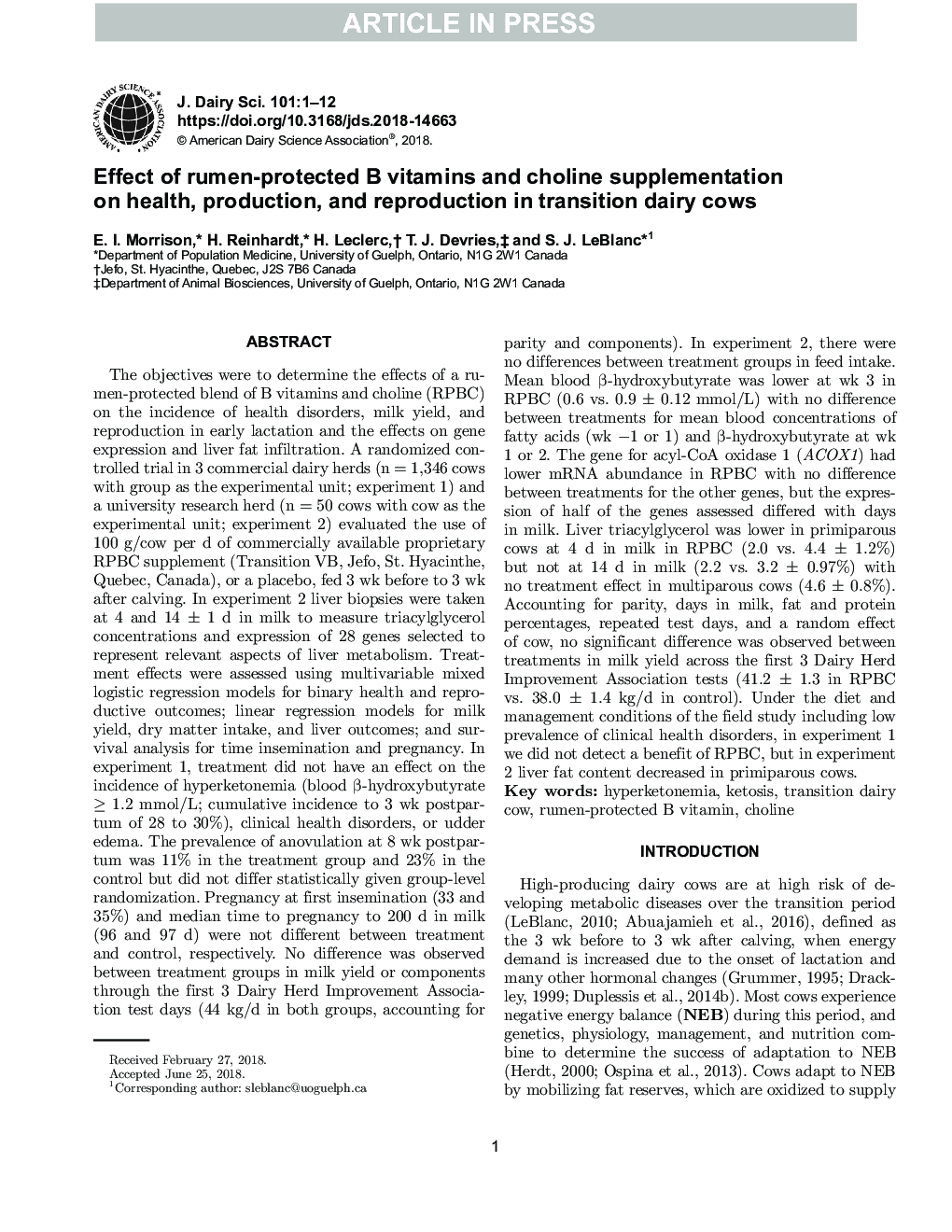| کد مقاله | کد نشریه | سال انتشار | مقاله انگلیسی | نسخه تمام متن |
|---|---|---|---|---|
| 10158066 | 1666505 | 2018 | 12 صفحه PDF | دانلود رایگان |
عنوان انگلیسی مقاله ISI
Effect of rumen-protected B vitamins and choline supplementation on health, production, and reproduction in transition dairy cows
دانلود مقاله + سفارش ترجمه
دانلود مقاله ISI انگلیسی
رایگان برای ایرانیان
موضوعات مرتبط
علوم زیستی و بیوفناوری
علوم کشاورزی و بیولوژیک
علوم دامی و جانورشناسی
پیش نمایش صفحه اول مقاله

چکیده انگلیسی
The objectives were to determine the effects of a rumen-protected blend of B vitamins and choline (RPBC) on the incidence of health disorders, milk yield, and reproduction in early lactation and the effects on gene expression and liver fat infiltration. A randomized controlled trial in 3 commercial dairy herds (n = 1,346 cows with group as the experimental unit; experiment 1) and a university research herd (n = 50 cows with cow as the experimental unit; experiment 2) evaluated the use of 100 g/cow per d of commercially available proprietary RPBC supplement (Transition VB, Jefo, St. Hyacinthe, Quebec, Canada), or a placebo, fed 3 wk before to 3 wk after calving. In experiment 2 liver biopsies were taken at 4 and 14 ± 1 d in milk to measure triacylglycerol concentrations and expression of 28 genes selected to represent relevant aspects of liver metabolism. Treatment effects were assessed using multivariable mixed logistic regression models for binary health and reproductive outcomes; linear regression models for milk yield, dry matter intake, and liver outcomes; and survival analysis for time insemination and pregnancy. In experiment 1, treatment did not have an effect on the incidence of hyperketonemia (blood β-hydroxybutyrate ⥠1.2 mmol/L; cumulative incidence to 3 wk postpartum of 28 to 30%), clinical health disorders, or udder edema. The prevalence of anovulation at 8 wk postpartum was 11% in the treatment group and 23% in the control but did not differ statistically given group-level randomization. Pregnancy at first insemination (33 and 35%) and median time to pregnancy to 200 d in milk (96 and 97 d) were not different between treatment and control, respectively. No difference was observed between treatment groups in milk yield or components through the first 3 Dairy Herd Improvement Association test days (44 kg/d in both groups, accounting for parity and components). In experiment 2, there were no differences between treatment groups in feed intake. Mean blood β-hydroxybutyrate was lower at wk 3 in RPBC (0.6 vs. 0.9 ± 0.12 mmol/L) with no difference between treatments for mean blood concentrations of fatty acids (wk â1 or 1) and β-hydroxybutyrate at wk 1 or 2. The gene for acyl-CoA oxidase 1 (ACOX1) had lower mRNA abundance in RPBC with no difference between treatments for the other genes, but the expression of half of the genes assessed differed with days in milk. Liver triacylglycerol was lower in primiparous cows at 4 d in milk in RPBC (2.0 vs. 4.4 ± 1.2%) but not at 14 d in milk (2.2 vs. 3.2 ± 0.97%) with no treatment effect in multiparous cows (4.6 ± 0.8%). Accounting for parity, days in milk, fat and protein percentages, repeated test days, and a random effect of cow, no significant difference was observed between treatments in milk yield across the first 3 Dairy Herd Improvement Association tests (41.2 ± 1.3 in RPBC vs. 38.0 ± 1.4 kg/d in control). Under the diet and management conditions of the field study including low prevalence of clinical health disorders, in experiment 1 we did not detect a benefit of RPBC, but in experiment 2 liver fat content decreased in primiparous cows.
ناشر
Database: Elsevier - ScienceDirect (ساینس دایرکت)
Journal: Journal of Dairy Science - Volume 101, Issue 10, October 2018, Pages 9016-9027
Journal: Journal of Dairy Science - Volume 101, Issue 10, October 2018, Pages 9016-9027
نویسندگان
E.I. Morrison, H. Reinhardt, H. Leclerc, T.J. DeVries, S.J. LeBlanc,